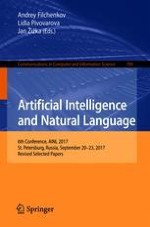2018 | Buch
Artificial Intelligence and Natural Language
6th Conference, AINL 2017, St. Petersburg, Russia, September 20–23, 2017, Revised Selected Papers
herausgegeben von: Andrey Filchenkov, Lidia Pivovarova, Jan Žižka
Verlag: Springer International Publishing
Buchreihe : Communications in Computer and Information Science
